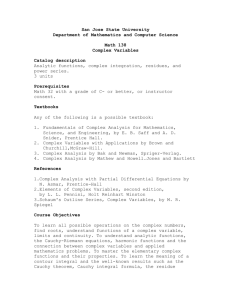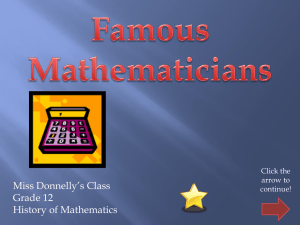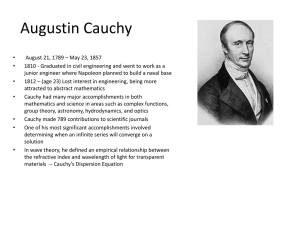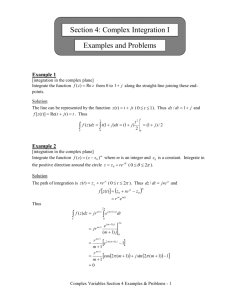Handout - amatyc
advertisement
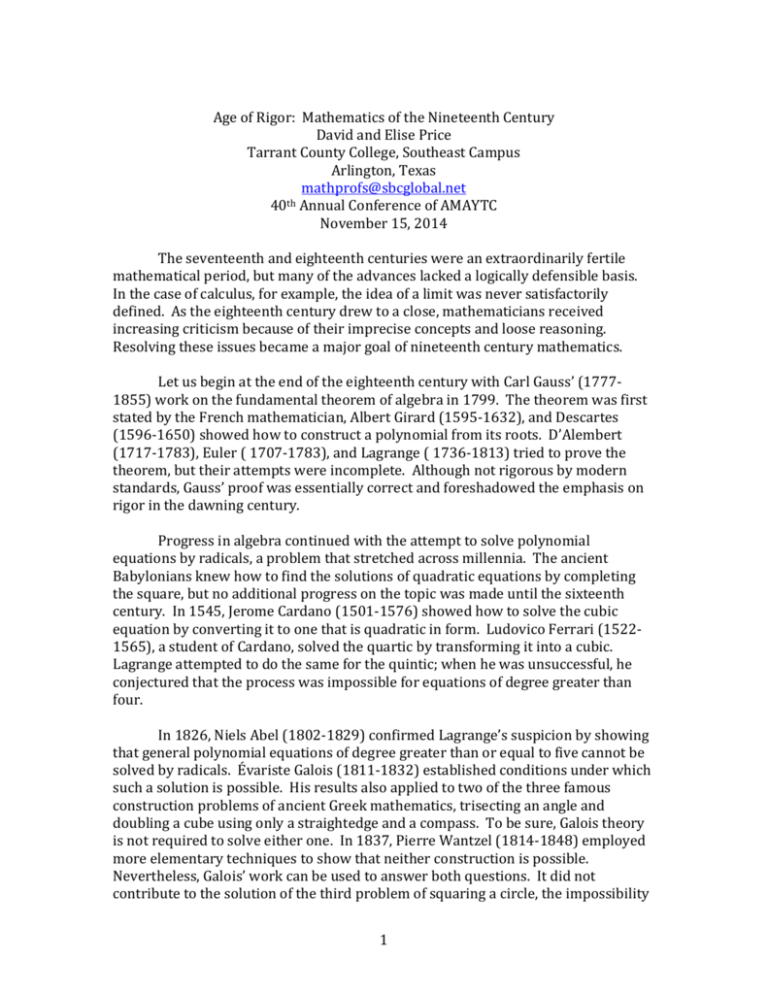
Age of Rigor: Mathematics of the Nineteenth Century David and Elise Price Tarrant County College, Southeast Campus Arlington, Texas mathprofs@sbcglobal.net 40th Annual Conference of AMAYTC November 15, 2014 The seventeenth and eighteenth centuries were an extraordinarily fertile mathematical period, but many of the advances lacked a logically defensible basis. In the case of calculus, for example, the idea of a limit was never satisfactorily defined. As the eighteenth century drew to a close, mathematicians received increasing criticism because of their imprecise concepts and loose reasoning. Resolving these issues became a major goal of nineteenth century mathematics. Let us begin at the end of the eighteenth century with Carl Gauss’ (17771855) work on the fundamental theorem of algebra in 1799. The theorem was first stated by the French mathematician, Albert Girard (1595-1632), and Descartes (1596-1650) showed how to construct a polynomial from its roots. D’Alembert (1717-1783), Euler ( 1707-1783), and Lagrange ( 1736-1813) tried to prove the theorem, but their attempts were incomplete. Although not rigorous by modern standards, Gauss’ proof was essentially correct and foreshadowed the emphasis on rigor in the dawning century. Progress in algebra continued with the attempt to solve polynomial equations by radicals, a problem that stretched across millennia. The ancient Babylonians knew how to find the solutions of quadratic equations by completing the square, but no additional progress on the topic was made until the sixteenth century. In 1545, Jerome Cardano (1501-1576) showed how to solve the cubic equation by converting it to one that is quadratic in form. Ludovico Ferrari (15221565), a student of Cardano, solved the quartic by transforming it into a cubic. Lagrange attempted to do the same for the quintic; when he was unsuccessful, he conjectured that the process was impossible for equations of degree greater than four. In 1826, Niels Abel (1802-1829) confirmed Lagrange’s suspicion by showing that general polynomial equations of degree greater than or equal to five cannot be solved by radicals. Évariste Galois (1811-1832) established conditions under which such a solution is possible. His results also applied to two of the three famous construction problems of ancient Greek mathematics, trisecting an angle and doubling a cube using only a straightedge and a compass. To be sure, Galois theory is not required to solve either one. In 1837, Pierre Wantzel (1814-1848) employed more elementary techniques to show that neither construction is possible. Nevertheless, Galois’ work can be used to answer both questions. It did not contribute to the solution of the third problem of squaring a circle, the impossibility 1 of which was shown by Ferdinand Lindemann (1832-1939) in 1882 when he proved that pi is a transcendental number. The achievements of Abel and Galois shifted the focus of algebra from computation to investigation of the structural features of an algebraic system. In particular, Galois introduced the concept of a group and Abel of a field. Some aspects of group theory were implicit in Gauss’ research in number theory, and Lagrange’s work on the theory of equations included the study of the permutations of the roots of a polynomial. Galois explicitly defined the concept of a permutation group. Arthur Cayley (1821-1895) first described the general idea of a group although he did not state all of its defining characteristics. In 1882, Heinrich Weber (1842-1913) gave a full axiomatic statement of the concept, and he also defined Abelian groups and isomorphisms. Galois, as well as Abel, contributed to the concept of a field by studying finite fields, and both Leopold Kronecker (1823-1891) and Richard Dedekind (18311916) focused on fields that contain the rational numbers. Once again, it was Weber who defined the idea axiomatically based on the earlier work. The solving of polynomial equations gradually led to the precise formulation of the concept of a complex number. Prior to the work on the cubic and the quartic, solutions of quadratic equations involving square roots of negative numbers had been rejected as meaningless. As the importance of complex numbers came to be recognized, Caspar Wessel (1743-1818) and Jean-Robert Argand (1768-1822) represented them as two-dimensional vectors, and Gauss considered them to be points in the complex plane. The Irish mathematician, William Rowan Hamilton (1805-1865), was the first to define a complex number as an ordered couple of real numbers. Some properties of vectors had been known for centuries. For example, Aristotle was aware of the parallelogram law to find the resultant of two forces. It now became possible to work with vectors algebraically, as well as geometrically. Hamilton wanted to extend the idea of a complex number to three dimensions to represent forces that do not lie in the same plane. After some fifteen years of effort, he realized that he had to abandon the commutative property of multiplication in order to do so. He introduced the concept of a quaternion, an expression of the form a + bi +cj +dk, where a is a scalar and the symbols i, j, and k have a function similar to the complex number i. Specifically, the square of each has the value of -1, as does the product ijk. The lack of commutativity results from the fact that ij = k, jk = i, and ki =j, but ji =-k, kj = -i, and ik =-j. Hamilton’s discovery of these relationships came to him in a flash of insight as he was walking across a bridge in Dublin, Ireland where he lived, and to commemorate his discovery, he carved the inscription i^2 = j^2 = k^2 = ijk = -1 into the bridge with his knife. Hamilton’s hope that quaternions would become the basis of mathematical physics was not realized, but his work still led to a significant advance. By dispensing with the scalar term of a quaternion and defining i, j, and k to be the unit 2 vectors along the x-, y-, and z-axes respectively, Josiah Willard Gibbs (1839-1903) and Oliver Heaviside (1850-1925) independently laid the foundation for threedimensional vector analysis. They defined the dot and cross products of two vectors, and Gibbs introduced the standard notation for each one. As we know, the cross product is noncommutative, and unlike the case with numbers, it can be zero even though neither vector is. The latter property is also true of the dot product although it is commutative. Hamilton’s introduction of noncommutative multiplication led to the investigation of new algebraic structures. Arthur Cayley made fundamental contributions to matrix theory by formulating many of its basic concepts. In particular, he defined matrix multiplication, which, of course, is not commutative. He also defined the addition of matrices, the zero matrix, and the identity matrix, and he observed that a system of linear equations in the same number of unknowns can be expressed in matrix form and solved by using the inverse of the coefficient matrix. Cayley also noted that if the determinant of the coefficient matrix is zero, then the matrix is not invertible. He made major contributions to a wide variety of mathematical fields, including the theory of determinants, analytic geometry, the theory of curves and surfaces, and especially invariant theory, an area in which he collaborated with James J. Sylvester (1814-1896). Although opposite in temperament, Cayley, who was serene and systematic, and Sylvester, who was volatile and disorganized, had a long, fruitful mathematical partnership. When Johns Hopkins University opened in 1876, it invited Sylvester to become a professor of mathematics. While there, he launched the American Journal of Mathematics, the first such publication in the United States. Developments in calculus provide the most extensive illustration of the emphasis on rigor during the nineteenth century. The impetus actually began in 1734 with the publication of The Analyst by the Irish philosopher and theologian, George Berkeley (1685-1753), who criticized the work of Newton (1642-1727) and others as conceptually incoherent. He did not deny the utility of the subject, but he asserted that its success resulted from a compensation of errors. For example, to prove that the derivative of f(x) = x^2 is 2x, we form the difference (x + h)^2 – x^2, divide it by h to obtain 2x + h, and take the limit as h approaches 0. Newton took the same approach, but he was unable to give a comprehensible explanation of the passage from 2x + h to 2x. Berkeley focused on this lack of an adequate definition of a limit to attack the answer as, in his famous phrase, “the ghost of a departed quantity.” Berkeley’s primary goal in writing The Analyst was to defend his religious views from attacks by Edmund Halley (1656-1742)and other advocates of calculus. However, mathematicians responded to Berkeley’s challenge by taking steps to fortify the foundations of the subject. Colin Maclaurin (1698-1746) observed that the calculation of a limit required working with an interval about the value at which the limit was being computed, not focusing strictly on the value itself. Jean D’Alembert recognized that calculus should be based on limits, but he did not 3 provide a precise definition of the concept. Lagrange attempted to base the subject on Taylor series expansions and thereby to make it an extension of algebra. He was motivated in part by the increasing importance of the concept of a function, which Euler had injected into the heart of mathematics. Lagrange’s failure to understand that the convergence of a series depends on limits doomed his approach to failure. However, his emphasis on functions helped to prepare the way for the successful resolution of the problem. One of the pioneers who provided a rigorous basis for calculus was the Czech priest, philosopher, and mathematician, Bernhard Bolzano (1781-1848), who essentially formulated the concept of a limit and used it to define both continuity and differentiability, as we do today. Prior to him, it had been assumed that continuous functions were differentiable throughout their domains. Bolzano was the first to construct a continuous function that is nowhere differentiable. He also observed that convergence of a series involves the concept of a limit, and his name is attached to two important theorems. Gauss used the intermediate value theorem in his proof of the fundamental theorem of algebra, but he justified it only geometrically, not analytically. Bolzano gave an analytic proof of it, and consequently it is sometimes referred to as Bolzano’s theorem. In addition, he stated the Bolzano-Weierstrass theorem, that a bounded infinite set has an accumulation point; Weierstrass later proved it. Because of Bolzano’s work on the foundations of calculus, Felix Klein referred to him as “the father of arithmetization.” The mathematician most responsible for shaping calculus as we know it was Augustin-Louis Cauchy (1789-1857). Although he and Bolzano were contemporaries, the latter worked in relative isolation, and his contributions went unnoticed for several decades. Cauchy understood that the concept of a limit provided the proper basis for the development of the subject, and he defined the idea rigorously. He expressed limits in terms of the algebraic inequalities that we use today, and his approach was so successful that even his epsilon-delta notation has become standardized. Ironically, although he chose the Greek letter epsilon to represent the error between a limit and an approximation of it, it now connotes a high degree of accuracy. Cauchy gave definitions of continuity and differentiability that agreed with those of Bolzano, and he defined the differential in terms of the derivative, as we do. Newton thought of a derivative as an “ultimate ratio,” and Leibniz viewed it as the ratio of two differentials. Cauchy was the first to conceive of it as the limit of a quotient, not as a quotient itself, and then to show that it could be represented as the quotient of two differentials. Although Lagrange stated the mean value theorem for derivatives, Cauchy used his definition of the derivative to give the first proof of it. He also proved that if a function has a positive derivative on an interval, it is increasing there, if the derivative is negative, it is decreasing, and if the derivative is zero, it is constant. In 4 addition, he constructed a proof of the intermediate value theorem that was more general than the one given by Bolzano. Prior to Cauchy, most mathematicians thought of integration as the inverse of differentiation rather than as the result of a process of summation. Although Leibniz took the latter approach, Newton, Jean Bernoulli, Euler, and Lagrange emphasized the former. Cauchy focused on the definite integral and emphasized that it was the limit of a sum. He may have been motivated to do so because, as we know, there is no way known to antidifferentiate some functions. After proving the additive property and the mean value theorem for integrals, he then established the precise relationship between definite and indefinite integration by providing the first proof of the fundamental theorem of calculus. His demonstration assumed that the integrand was continuous; he later extended the concept to include an integrand with finitely many discontinuities on an interval, and he defined both types of improper integrals. When Cauchy partitioned an interval and calculated a sum to approximate a definite integral, he computed the function value for each subinterval at the lefthand endpoint. Bernhard Riemann (1826-1866) generalized Cauchy’s approach by allowing the function value to be calculated at any point in the interval. He also developed a criterion to determine when a function with infinitely many discontinuities is integrable, and he formulated the definition of the definite integral in terms of upper and lower sums. We have noted that Cauchy used inequalities to represent limits, continuity and differentiability, but he defined these concepts verbally. Karl Weierstrass (1815-1897) used Cauchy’s epsilon-delta notation to express each definition symbolically . He also made fundamental contributions to complex analysis, including the use of power series to represent functions, and he introduced the concepts of analytic continuation, points of singularity, and analytic functions of several variables. By proving the extreme value theorem, that a continuous function defined on a closed interval has an absolute maximum and an absolute minimum, and constructing an example of a function that is everywhere continuous but nowhere differentiable, he duplicated some of Bolzano’s work that was unknown to him. His lectures on calculus at the University of Berlin were so influential that he became known as the “father of modern analysis.” Like Bolzano, Cauchy drew a clear distinction between convergent and divergent series and showed that convergence is a limiting process. He developed several convergence criteria, including the comparison, ratio, root, and alternating series tests. He also introduced the concept of absolute convergence and devised what we call the Cauchy condition for the convergence of a sequence, that a sequence converges if and only if the distance between its terms approaches zero as the index of the sequence increases. His proof of it was incomplete, however, because he did not have an adequate definition of a real number. As a result, he could show that the test was necessary but not that it was sufficient. 5 Cauchy thought he had proved that the limit of a convergent infinite series of continuous functions is continuous. However, Joseph Fourier (1768-1830) in his work on trigonometric series discovered a counterexample to Cauchy’s result. The issue was resolved by Weierstrass, who was the first mathematician to draw a distinction between a series of numbers and one of functions. He then formulated the concept of uniform convergence and used it to correct Cauchy’s proof. He also proved that a uniformly convergent series can be integrated term by term. Eduard Heine (1821-1881) made a similar contribution to the understanding of continuity. He defined the concept of uniform continuity and proved that a function that is continuous on a closed interval is uniformly continuous there. His demonstration used without proof what we call the Heine-Borel covering theorem, that an open cover of a closed interval has a finite subcover. It was later proved by the French mathematicians, Émile Borel (1871-1956) and Henri Lebesgue (18751941). Borel proved it for a countably infinite cover and Lebesgue for an arbitrary one. The lack of a proof for the sufficiency of the Cauchy criterion stimulated efforts to define irrational numbers rigorously. The earliest attempt to resolve the issue, which predates Cauchy’s work by centuries, appears in Book V of Euclid’s Elements and presents the theory of the Greek mathematician, Eudoxus (408-355 BC). The approach is geometrical, not arithmetic, in nature and represented the Greeks’ resolution of the crisis precipitated by the Pythagorean discovery of incommensurable magnitudes. When Richard Dedekind’s attention was drawn to the problem while teaching calculus, he arithmetized Eudoxus’ contribution by means of his concept of Dedekind cuts. Weierstrass lectured on an approach that was published by Ernst Kossack (1839-1902), one of his students, and that defined irrational numbers essentially on the basis of decimal representations. Georg Cantor (1845-1918), another student of Weierstrass, began with Cauchy sequences, which he called fundamental sequences, and developed his theory on the basis of them. The work of Dedekind, Weierstrass, and Cantor on irrational numbers was published in 1872. In 1869, the French mathematician, Charles Meray (1835-1911), offered a solution similar to Cantor’s but it received little attention. Heine, yet another student of Weierstrass, also wrote on the topic in 1872, taking the same approach as Cantor. Geometry was another area affected by the nineteenth century’s emphasis on rigor. For centuries, mathematicians had raised questions about Euclid’s parallel postulate. As originally formulated, it says that if two lines are cut by a transversal such that the sum of the interior angles on one side of the transversal is less than two right angles, then the lines will intersect on that side. Its statement seemed to be far less obvious than the other assumptions in the Elements. Beginning with Claudius Ptolemy, several unsuccessful attempts to prove it from Euclid’s other nine 6 axioms were undertaken. Gerolamo Saccheri (1667-1733), a professor at the University of Pavia in Italy, made the most extensive effort in this regard when he tried to construct a proof by contradiction. Although he mistakenly thought that he was successful in doing so, he actually developed a non-Euclidean geometry. Early in the nineteenth century, three mathematicians, Gauss, the Hungarian, John Bolyai (1802-1860), and the Russian, Nikolai Lobachevsky (1793-1856), independently constructed a non-Euclidean geometry by assuming that through a point not on a line, more than one parallel can be drawn to the line. All three initially attempted to prove the parallel postulate from Euclid’s other axioms, but each one eventually concluded that no such proof is possible. Gauss probably did his work first, but he did not publish it, whereas both Bolyai and Lobachevsky did publish theirs. Although this discovery did not attract attention immediately, it generated considerable interest following Gauss’ death when his results were found in his notes. The effect was revolutionary because it raised the possibility that more than one geometric description of space is possible. Advances were also made in differential geometry. Euler had observed that points on a surface can be represented by means of parameters. Gauss used this approach to study surfaces systematically. One of his achievements was to introduce the concept of the curvature of a surface and to develop a means of calculating it. He also showed that surfaces could be studied as spaces in themselves instead of considering them to be embedded in Euclidean space. Riemann generalized Gauss’ work on surfaces to develop what is known today as Riemannian geometry, in which there are no parallel lines and all lines have finite length. Early in the twentieth century, Albert Einstein (1879-1955) applied Riemannian geometry to his general theory of relativity. Euclid’s Elements had been admired for centuries as the model of mathematical rigor, but mathematicians were aware that there were some flaws in its development. Although Aristotle, the father of the axiomatic method, understood the need for undefined terms, Euclid attempted to define all of his concepts, including “point,” “line,” and “plane.” Also, some of the proofs used ideas not explicitly justified by the axioms and postulates with which he began. The emergence of non-Euclidean geometry focused attention on improving the rigor of the Elements. Several mathematicians, including Morris Pasch (1843-1930), Giuseppe Peano (1858-1932), Oswald Veblen (1880-1960), G. D. Birkhoff (18841944), and David Hilbert (1862-1943) contributed to this effort. In 1899, as the nineteenth century drew to a close, Hilbert presented an extensive axiomatic development of Euclidean geometry in his work, Foundations of Geometry. Prior to the nineteenth century, female mathematicians were rare; the best known are Hypatia (350-415) in the fourth century and Maria Agnesi (1718-1799) in the eighteenth. The nineteenth century saw the participation of an increasing number of women, including Sophie Germain (1776-1831) of France. Although she was not allowed to enroll in the École Polytechnique, she obtained lecture notes 7 from professors there, taught herself mathematics, and made contributions to number theory and differential geometry. Using a male pseudonym, M. LeBlanc, she corresponded with Lagrange and Gauss, both of whom praised her work. Gauss later learned that she was a woman and recommended that the University of Göttingen award her an honorary degree. Unfortunately, she died before she could receive it. Mary Fairfax Somerville (1780-1872) of Scotland studied Laplace’s Celestial Mechanics on her own and wrote a detailed explanation of it that was used in British universities for many years. Her work inspired the astronomer, John Couch Adams, to seek a new planet in order to explain irregularities in the orbit of Uranus, a search that led to his discovery of Neptune. Somerville College at Oxford is named for her. Sonia Kovalevsky (1850-1891) was born in Russia but moved to Heidelberg in 1868 because she could not pursue higher education in her homeland. She took classes from a student of Weierstrass and then went to Berlin to study with the master himself. The university there would not admit her, but Weierstrass accepted her as a private student. She worked with him for four years and wrote three important papers, including one on partial differential equations. The University of Göttingen awarded her a degree in 1874, and in 1888, she won a major prize from the French Academy. She became a professor of mathematics at the University of Stockholm and is often considered to be the first professional female mathematician in history. Emmy Noether (1882-1935) was born in Erlangen, Germany, where her father was a professor of mathematics at the University of Erlangen. She studied there and with Hilbert’s support eventually taught at Göttingen. With the rise of Hitler, she was dismissed from her position, but she emigrated to the United States and taught at Bryn Mawr College in Pennsylvania. Her particular interest was abstract algebra, especially ring theory. The nineteenth century also saw a rapid increase in the founding of mathematical journals. In 1826, A. L. Crelle (1780-1855), established the Journal for Pure and Applied Mathematics in Germany, followed in 1836 by a similar publication started by Joseph Liouville (1809-1882) in France. As we have mentioned, J. J. Sylvester launched the American Journal of Mathematics in 1878. In 1882, Gösta Mittag-Leffler (1846-1927) began to publish Acta Mathematica in Sweden. A concurrent development involved the growth of professional organizations. In 1865, the London Mathematical Society was founded, as were similar groups in Scotland, France, Italy, and Germany shortly thereafter. Charlotte Angas Scott (1858-1931), Emmy Noether’s predecessor at Bryn Mawr, played an active role in the founding of the New York Mathematical Society, which was the precursor of the American Mathematical Society. 8 Developments in the nineteenth century also changed the manner in which mathematicians earned a living. Historically, they had often depended on a royal patron. For example, both Frederick II and Catherine the Great supported Euler. As the Industrial Revolution expanded, the need for mathematical and scientific education increased and reinforced the nineteenth century’s emphasis on rigor. Royal sources of employment declined and were replaced by professorships at schools and universities. As mathematicians assumed teaching responsibilities, they became more aware of the need to address foundational questions, confirming Aristotle’s observation that one does not truly understand a subject until one can explain it to a novice. As we have noted, Dedekind was motivated to develop his theory of irrational numbers as a result of teaching calculus, and Weierstrass was a legendary professor at the University of Berlin. Another example was Cauchy, who taught at the École Polytechnique in Paris. As the nineteenth century drew to a close, its emphasis on the axiomatic method and the structural features of concepts launched new areas of inquiry, including set theory and topology. Other lines of investigation, such as the automation of computation, were only in their infancy but exploded in the twentieth century. In 1900, Hilbert addressed the International Congress of Mathematicians and discussed several problems on a list of twenty-three questions that he recommended to their attention, some of which, for example, the Riemann hypothesis, remain open to this day. His suggestions helped to fuel the continued growth of mathematics for the next hundred years. Bibliography Boyer, C. (1968). A History of Mathematics, New York: John Wiley & Sons, Inc. Boyer, C. (1949). The History of the Calculus and its Conceptual Development, New York: Dover Publications, Inc. Eves, H. (1990). An Introduction to the History of Mathematics (6th Ed.). Philadelphia: Saunders College Publishing. Grabiner, J. (1981). The Origins of Cauchy’s Rigorous Calculus, Cambridge: The MIT Press. Katz, V. (2009). A History of Mathematics: An Introduction (3rd Ed.). Boston: Addison-Wesley. Kline, M. (1972). Mathematical Thought from Ancient to Modern Times, New York: Oxford University Press. 9


